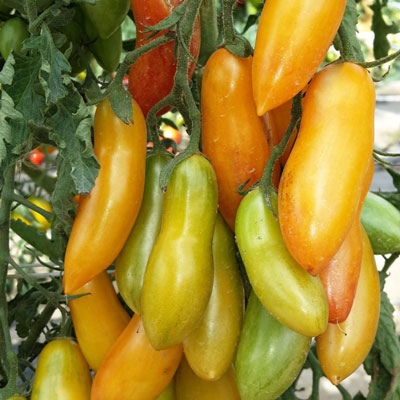
- Category: hybrid
- Growth type: indeterminate
- Appointment: fresh consumption
- Ripening period: mid-season
- Growing conditions: for open ground, for film greenhouses
- Marketability: high
- Ripe fruit color: honey pink
- Fruit shape: elongated-cylindrical, with a spout
- Fruit weight, g: 70-80
- Fruit taste: dessert sweet-fruity
Among the huge number of tomato varieties, there are those whose names include their properties. A striking example of this is the hybrid of the Russian selection Honey fingers, which differs not only in its interesting appearance, but also in its sweetish taste, with a pronounced honey note. However, this thermophilic crop can be grown mainly under cover.
Breeding history
F1 Honey Fingers is a 1st generation hybrid. The culture was created by breeders from Russia, there is data on inclusion in the State Register in 2010, but this information has not been confirmed.
Description of the variety
As already mentioned, Honey fingers is a thermophilic plant. Experts recommend cultivation indoors, but there is an exception - these are the southern territories, where it is possible to cultivate such tomatoes in open beds.
As for the main characteristics, the culture is indeterminate, that is, growth is not limited throughout the season, therefore it can grow up to 1.8-2 m. Well leafy bushes have a stem, there are no shoots on the lower part of the shoots. Dark greens are noted on the leaves. The arrangement of the flower-bearing brushes is alternate. In each tassel, 5-10 ovaries are formed.
The main qualities of the fruit
Still unripe tomatoes Honey fingers are light green, but with the onset of ripeness the tomatoes become a beautiful honey color, with the addition of a pink tint, they look very bright in the sun, literally burn against the background of foliage. And, of course, the shape is different - it is quite elongated, indeed, reminiscent of fingers. Each tomato has a small nose. Such tomatoes weigh 70-80 grams, the second wave is slightly less, about 60 g. Inside there are 2, in some cases 3, chambers with seeds.
Taste characteristics
The delicious fruits of Honey Fingers are versatile in use. In addition to salads, vegetables are used for:
- sandwiches;
- soup dressings;
- vegetable caviar, lecho;
- whole-fruit conservation.
Ripening and fruiting
The hybrid in question is a typical mid-season crop. Its ripe fruits will be formed within 105 to 115 days.
Yield
Tomatoes of the considered variety have good yield indicators. In sources you can read about indicators such as 5 kilograms per plant.
The timing of planting seedlings and planting in the ground
Ready tomato seedlings are planted at the age of 60-65 days. Accordingly, the timing of sowing grains and transshipment of grown shoots will depend on the specific region.

Growing tomato seedlings is an extremely important process, because it largely depends on whether the gardener will be able to harvest at all. All aspects must be taken into account, from seedbed preparation to planting in the ground.
Landing scheme
We can say that when planting, the most common scheme is used - 3-4 plants per square meter.

Growing and care
The tomato variety in question is traditionally cultivated in seedlings, while picking at the stage of one or two leaves is mandatory. As already mentioned, the crop can also be grown in an open area, in a vegetable garden or in a garden. However, at the same time, the bush will grow at a much lower height, but the plants themselves will become resistant, as well as more hardy.
Some even prefer this method of growing, as it provides the culture with clean air, plenty of sun, and sufficient moisture. Many people say that under these conditions it is possible to grow tomatoes of just excellent quality, which cannot be achieved with greenhouse cultivation.
Bushes of Honey Fingers should be tied to a solid support, and it is also necessary to form them into 1-2 stems. Side shoots must be removed. The culture needs regular watering, with the obligatory subsequent weeding and loosening, as well as mulching the soil. Do not forget about feeding.




A plant needs different micronutrients at each stage of growth. All fertilizers can be divided into two groups: mineral and organic. Folk remedies are often used: iodine, yeast, bird droppings, eggshells.
It is important to observe the rate and period of feeding. This also applies to folk remedies and organic fertilizers.



























































































